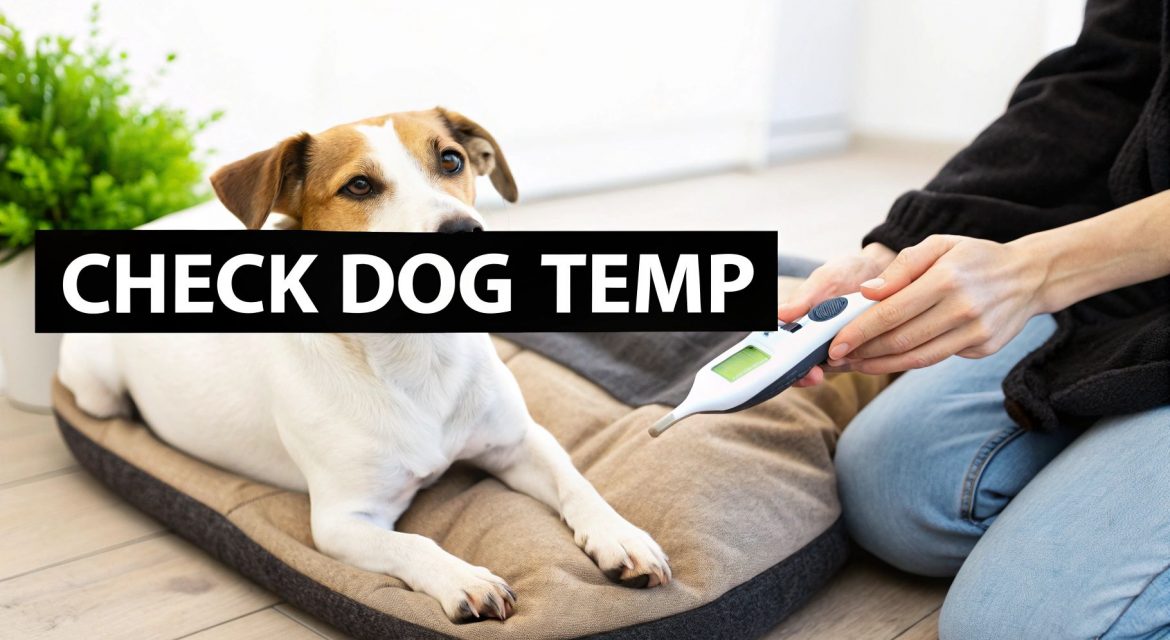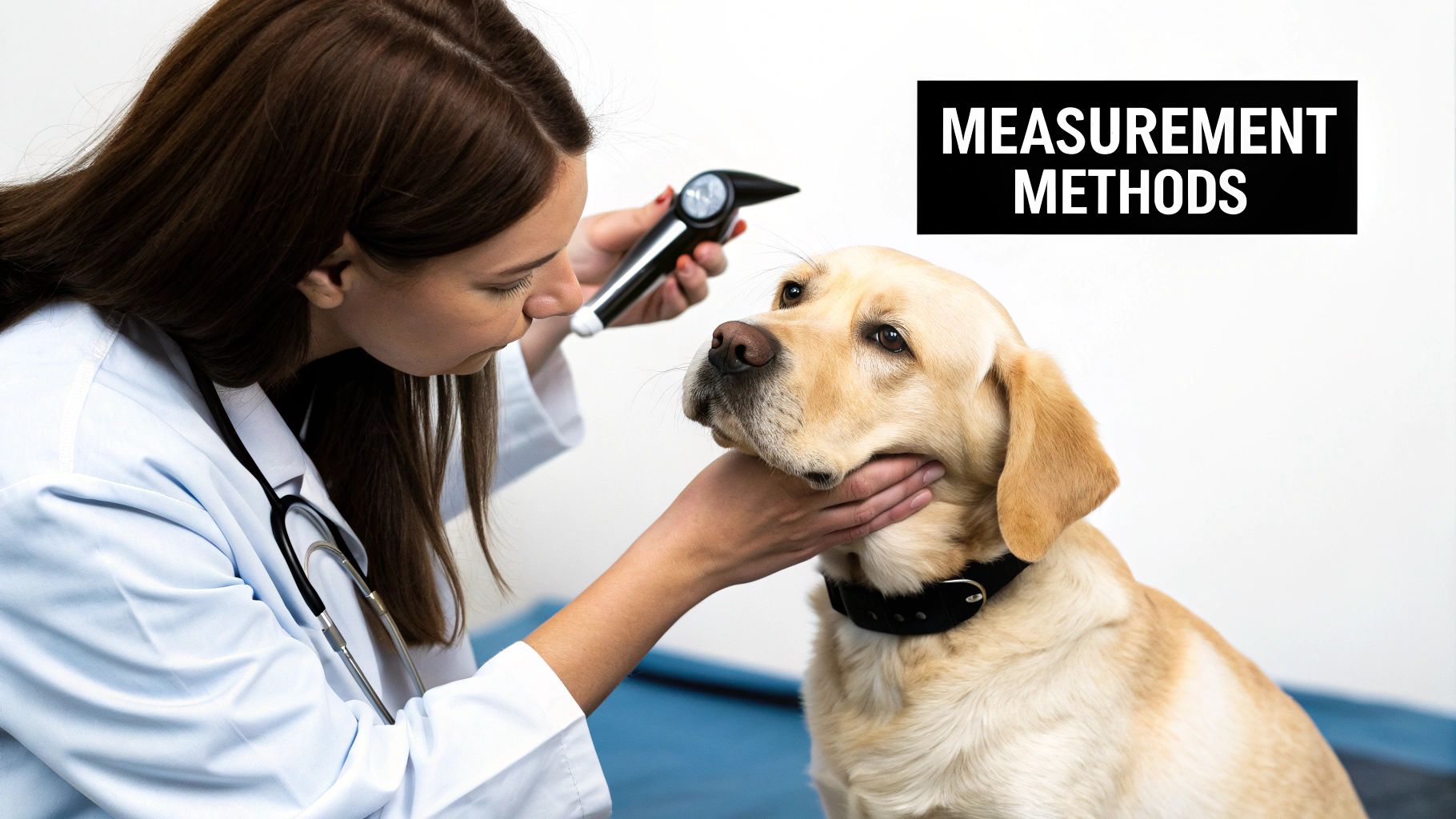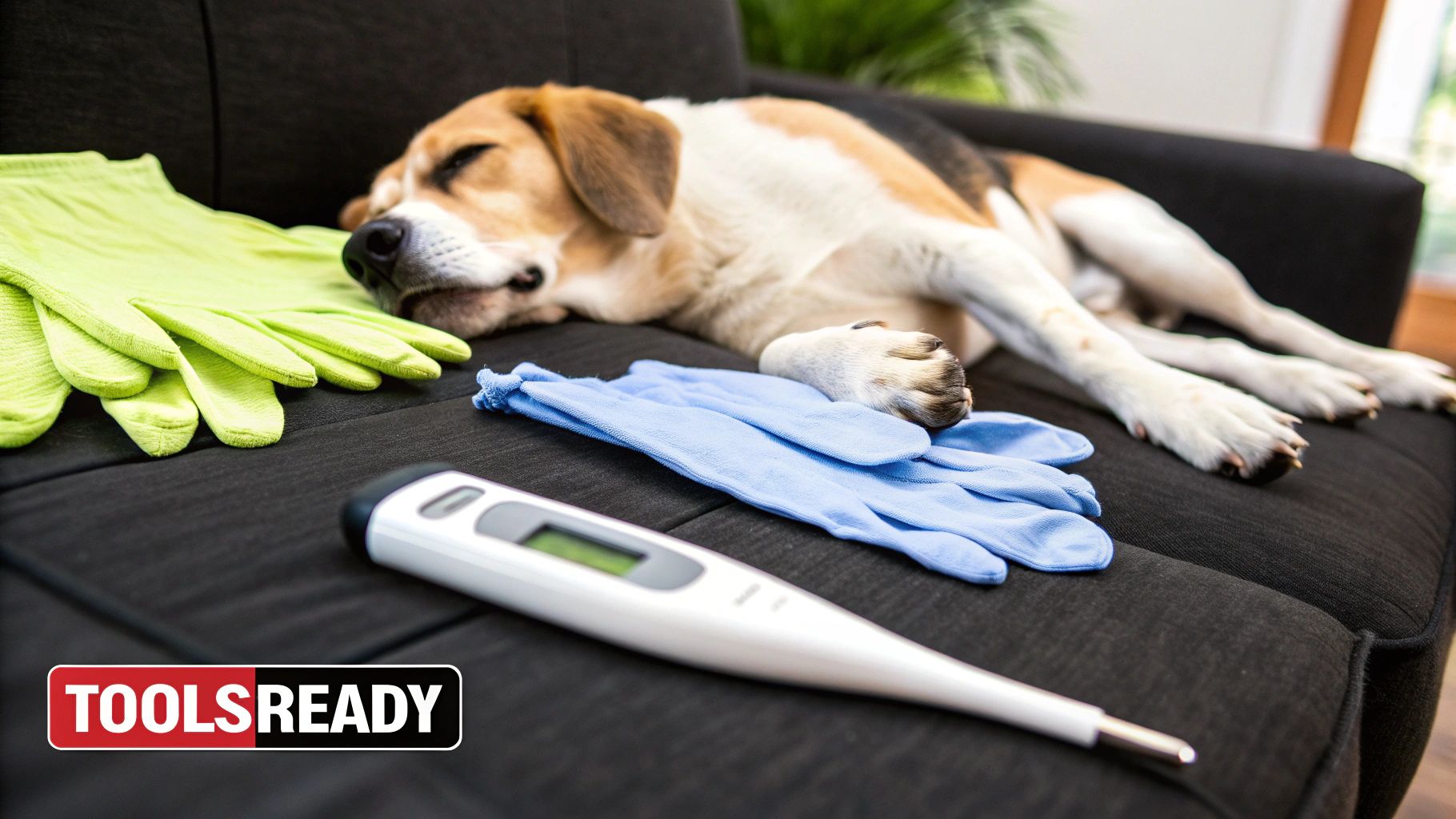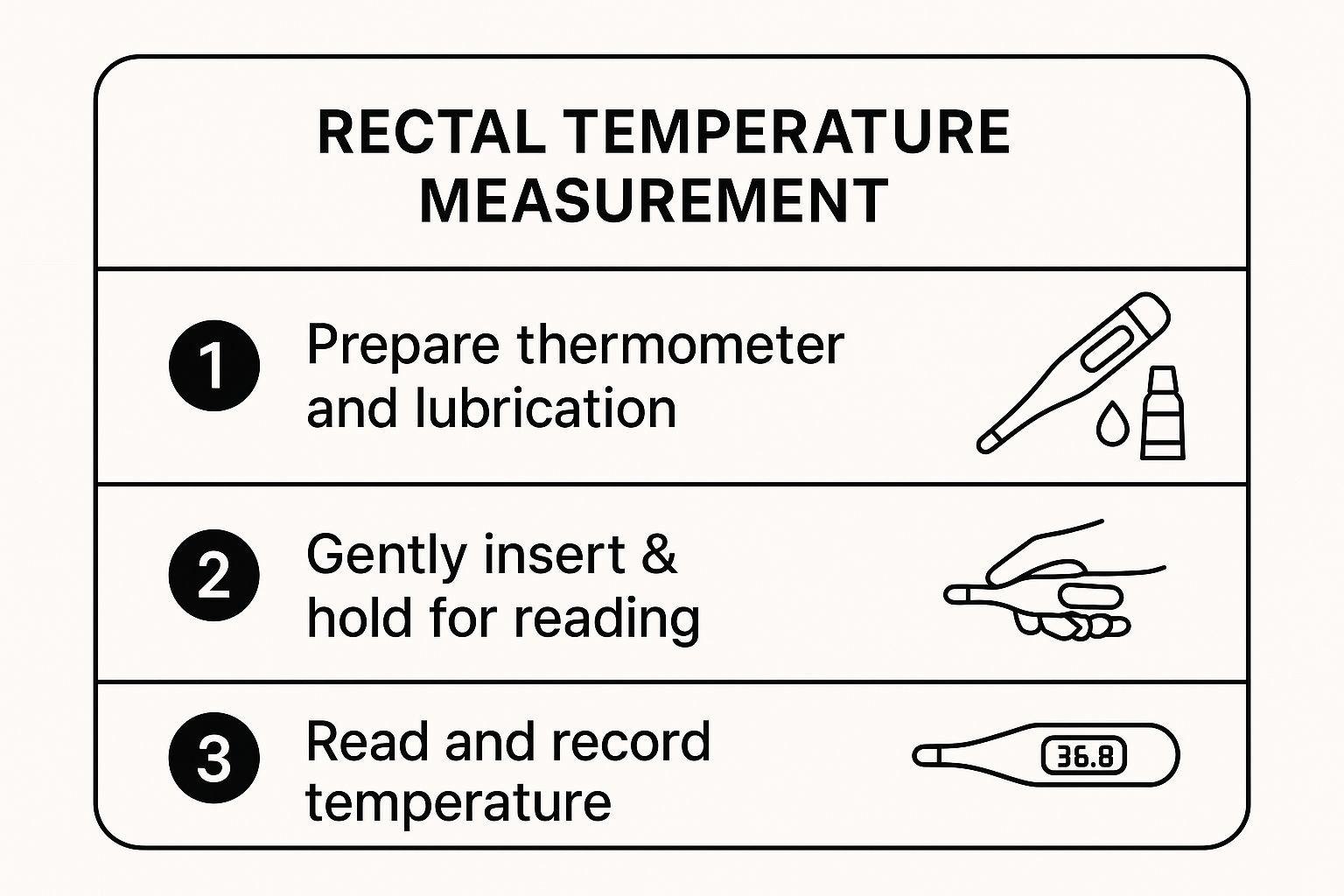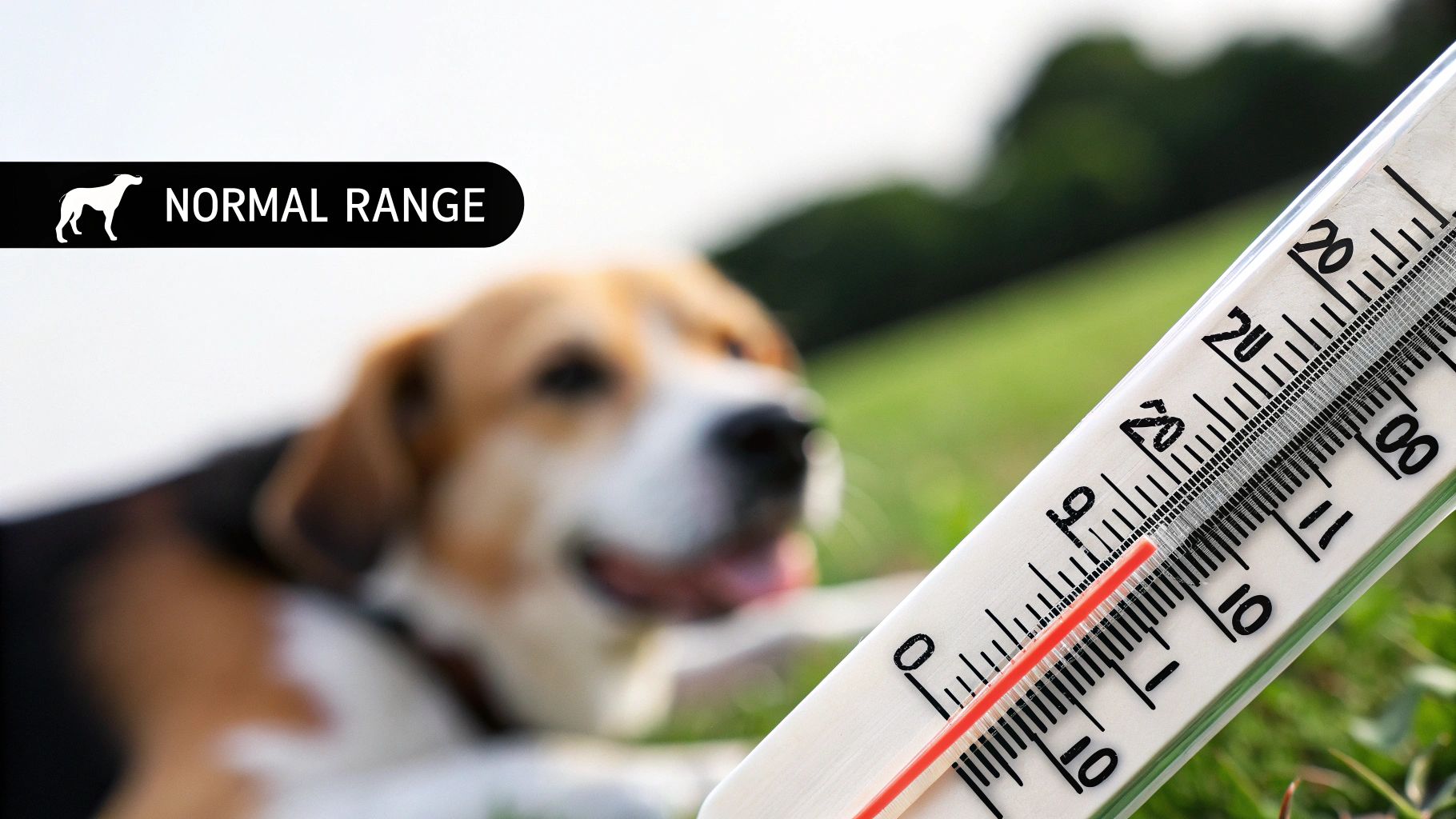Knowing how to check your dog's temperature is a vital skill, and we know it all starts with you noticing those little signs that something’s off. Getting a quick, accurate reading with a digital thermometer is the most reliable way to know what's going on inside their body. Trusting your gut when your dog's behaviour changes is always the first, and most important, step. We're in this together.
Why You Should Check Your Dog's Temperature
As dog parents, we're completely in tune with our dogs' routines and moods. We know their favourite spot on the sofa, the exact wag of their tail that means they're truly happy, and all the little quirks that make them who they are.
So, when that familiar energy suddenly dips, it’s impossible not to feel a pang of worry. Learning to spot the signs that call for a temperature check means you can act quickly and with confidence, offering your furry friend the comfort they need.
Knowing these cues is a huge part of proactive dog health and care. Instead of just guessing, you get a clear, factual piece of information about how they're feeling, which is so reassuring.
Common Signs Your Dog Might Be Unwell
Sometimes the signs are glaringly obvious, but often they’re much more subtle. Your dog can’t tell you they feel poorly, so it’s up to us to be their advocate. Let's keep an eye out for these common indicators together:
- Lethargy or Unusual Tiredness: Is your usually bouncy pup refusing to leave their bed or showing zero interest in their favourite squeaky toy? A sudden drop in energy is a big red flag.
- Shivering or Trembling: While shivering can just mean they’re cold or excited, unexplained trembling when it's warm enough could signal a fever or that they feel chilled from illness.
- Loss of Appetite: When a dog who normally inhales their dinner suddenly turns their nose up at it, they're often telling you something isn't right.
- Physical Cues: Pay attention to a warm, dry nose, ears that feel unusually hot, or a tummy that feels warmer than normal to your touch.
It’s all about telling the difference between a dog having a simple 'off day' and one showing symptoms that need a closer look. Your intuition as a pet parent is often your most valuable tool. You know your dog better than anyone.
Interestingly, a dog's temperature can become dangerous in some surprising conditions. A UK study found that dogs can suffer from heat-related illness even on mild or cool days. One case was even recorded at just 3.3°C, especially after exercise. This really drives home why watching their behaviour is just as crucial as checking the weather forecast.
Before you even think about getting near your dog with a thermometer, let's get our kit together. Being prepared is the secret to making this as quick and stress-free as possible for everyone involved. Trust us, fumbling around for supplies while trying to keep a worried dog still is a recipe for disaster.
Think of it like setting the stage for a calm procedure. You wouldn’t start baking without getting your ingredients out first, would you? It’s the same idea here, and getting organised makes a world of difference to your dog's comfort and your own peace of mind.
Choosing Your Thermometer
The most important tool is, of course, the thermometer. You’ve got two main pet-friendly options, and the best one really comes down to your dog’s personality and what you’re comfortable with.
- Digital Rectal Thermometer: This is what your vet uses, and for good reason. It’s the gold standard for accuracy and gives you the most reliable reading of your dog's core body temperature.
- Digital Ear Thermometer: This is a less invasive choice, designed specifically for the shape of a dog's ear canal. It can be a great alternative for dogs who get particularly anxious about being handled.
No matter which type you go for, it absolutely has to be a digital one. Let's forget about the old mercury thermometers. Digital versions are faster, safer, and so much easier to read—exactly what you need when your pet is feeling poorly and you’re feeling stressed.
Once you have one, make it the dedicated ‘dog thermometer’ and label it clearly. It’s a simple hygiene step that prevents any awkward mix-ups down the line.
Beyond the thermometer itself, you'll need a water-based lubricant if you're using the rectal method—this is non-negotiable for their comfort and safety. Also, grab some of your dog’s absolute favourite treats to help build a positive association.
And a final tip from our experience: if you can, enlist a helper. An extra pair of hands to offer a bit of gentle reassurance and a steadying presence can be your greatest asset in getting a quick, accurate reading.
Taking a Rectal Temperature: The Most Accurate Method
We know what you might be thinking, and trust us, you're not alone. The idea of taking a rectal temperature can feel a bit daunting for any dog parent. But we're here to walk you through it, because this method is considered the gold standard by veterinarians for a reason.
It gives you the most precise reading of your dog's core body temperature, and learning how to do it safely is an invaluable skill for their care.
First things first, let’s get everything ready. Grab your digital rectal thermometer, a water-based lubricant, and some of your dog’s absolute favourite treats. Have them all within arm's reach.
Your calm energy is the most important tool you have. Your dog will pick up on your confidence, so let's take a deep, steadying breath before we begin.
Getting Started Gently
The key here is to make your dog feel secure, not restrained.
If you have a helper, one person can gently hug the dog to their body, speaking in a soft, reassuring voice while offering a treat to distract them. If you’re flying solo, have your dog stand and use your non-dominant arm to reach over their back, steadying their body against yours.
Once they seem relatively calm, apply a generous amount of lubricant to the tip of the thermometer. This step is absolutely crucial for their comfort and safety. Please don't skip it.
Gently lift your dog's tail with one hand. With the other, calmly and slowly insert the lubricated thermometer into their rectum — about one inch deep for small dogs and up to two inches for larger breeds. Never, ever force it. If you feel resistance, stop and reposition.
Your goal is a smooth, gentle insertion. Think of it like putting a key in a lock—it shouldn't require any real pressure. Your calm, steady hand makes all the difference in keeping your dog relaxed during this brief moment.
Taking the Reading and Finishing Up
Hold the thermometer in place until it beeps, which usually only takes about 10-30 seconds with most modern digital models. All the while, keep speaking to your dog in that same soothing tone.
As soon as it beeps, gently remove the thermometer. Read the digital display and make a note of the temperature.
Then, immediately praise your dog like they just won an Olympic medal and give them that well-deserved treat! This positive reinforcement is brilliant for helping them associate the experience with something good.
Finally, clean the thermometer thoroughly with rubbing alcohol or soapy water, and pop a label on it for "dog use only." You've just performed a vital health check with compassion and care — well done you!
Using an Ear Thermometer: A Less Invasive Alternative
Let's be honest, the rectal method, while being the gold standard for accuracy, isn't exactly a pleasant experience for anyone involved. If you've got a dog that's particularly anxious or sensitive, trying to take their temperature this way can quickly turn into a stressful ordeal. We completely get that.
This is where a good quality digital ear thermometer—one designed specifically for pets—can be a real lifesaver. It’s a fantastic, less invasive option that’s much more comfortable for your furry friend.
Mastering the Technique
Getting an accurate reading with an ear thermometer is all about the technique. A dog's ear canal isn't a straight shot; it's shaped like an 'L', with both a vertical and a horizontal part. To get a proper reading, the thermometer's probe needs to go deep enough to pick up the heat waves coming right from the eardrum. This reflects the body's core temperature.
If you don't go deep enough, you'll end up measuring the temperature of the outer ear canal, which will give you a false, usually lower, reading.
Start by gently holding your dog’s head still. With your other hand, lift their ear flap up and slightly out. This helps to straighten the L-shaped canal, giving you a clearer path. Carefully insert the probe into the horizontal part of the canal, aiming it towards your dog's nose.
Hold it steady until the device beeps to signal it's done. And that’s it!
This visual guide breaks down the core actions, reminding us that no matter which tool you use, a successful temperature check comes down to being calm, prepared, and organised.
Now, it's important to have realistic expectations. Research on exercising dogs in the UK's East Midlands found that ear temperature readings can sometimes lag behind the true core body temperature. However, the same study confirmed that they are a practical and much kinder method for monitoring, which is a massive win for many dogs. You can discover more insights about these temperature monitoring findings.
The bottom line? A reading from an ear thermometer might not be quite as precise as a rectal one. But a slightly less accurate reading is always better than no reading at all, especially if it means keeping your dog calm and comfortable. If you get a result that worries you, you can always follow up with your vet.
Rectal vs Ear Thermometer At a Glance
Choosing the right thermometer can feel tricky. You're balancing accuracy with your dog's comfort and your own confidence in using the tool. This quick comparison should help you decide which method is the best fit for you and your dog.
| Feature | Rectal Thermometer | Ear (Tympanic) Thermometer |
|---|---|---|
| Accuracy | Considered the gold standard for core body temperature. | Good, but can be less precise if not positioned correctly. |
| Ease of Use | Requires lubricant and keeping your dog very still. | Quicker and cleaner, but requires proper technique for accuracy. |
| Dog Comfort | Highly invasive and can be stressful or uncomfortable for dogs. | Much less invasive and better tolerated by most dogs. |
| Speed | Takes around 60 seconds for a digital reading. | Very fast, often providing a reading in just 1-2 seconds. |
| Best For | Situations where absolute accuracy is critical; vet-recommended. | Routine checks at home, anxious dogs, or when speed is a priority. |
Ultimately, both methods have their place. While vets will always rely on the rectal method for its precision, having an ear thermometer at home is a practical way to keep an eye on your dog's health without causing them unnecessary stress.
What Do the Numbers Mean: Interpreting Your Results
So, you’ve managed to get a reading – well done! We know that’s often the hardest part. But now you’re staring at a number on a thermometer, wondering what on earth it actually means for your dog.
First things first, a dog's normal body temperature is naturally higher than ours. What would feel like a fever for you is just a regular Tuesday for them.
A healthy dog’s rectal temperature usually sits somewhere between 38.3°C and 39.2°C (101°F and 102.5°F). If your reading is in this zone, you can probably breathe a sigh of relief.
But context is everything. A slightly higher temperature after a frantic zoom around the park is completely different to that same reading in a dog who’s been moping on the sofa all day.
Understanding the Temperature Ranges
Let's break down what those numbers might be trying to tell you. This will help you turn that digital display into actionable information, so you know exactly what to do next.
- Low Temperature (Below 37.8°C): This is a red flag for hypothermia and is a serious concern. If your dog feels cold to the touch and their temperature has dropped this low, you need to ring your vet immediately.
- Mild Fever (39.3°C – 40.5°C): A slight fever often means your dog’s body is doing its job and fighting off a minor infection. It’s a sign to keep a very close eye on them for any other symptoms.
- High Fever (Above 40.5°C): A temperature this high is a clear warning sign. Anything above 41°C is particularly dangerous and can point to a serious issue like heatstroke, requiring urgent veterinary attention.
Interestingly, a study on agility dogs in the UK found that some dogs’ ear temperatures shot past 40.6°C right after a race. That’s the equivalent of a critical rectal temperature of 41°C, which is the threshold for heatstroke risk.
If you ever see a number that high, it's time to get professional advice without delay. You can also brush up on our guide covering the early signs of a dog overheating.
Your Questions Answered
If you're feeling a bit unsure about taking your dog's temperature, you're definitely not alone. It's a common hurdle for many of us dog parents. We've pulled together some of the most frequent questions we get to help clear things up and give you that extra bit of confidence.
Most of us worry about hurting our dog. It's a valid concern! The good news is, for most dogs, it's more of a weird, slightly undignified moment than a painful one. As long as you use plenty of lubricant and keep your cool, they'll likely just be a bit confused for a minute. Your calm, gentle handling makes all the difference.
Can I Use a Human Thermometer?
Yes, you can absolutely use a standard digital thermometer meant for people to get a rectal reading. Just do yourself a favour and label it clearly as the "dog's thermometer" afterwards! You don't want any mix-ups.
However, you should never use a human ear thermometer. They simply aren't designed for a dog's L-shaped ear canal, so the reading will be wildly inaccurate.
It’s also best to steer clear of the old glass mercury thermometers. They’re fragile, take ages to get a reading, and are a real safety hazard if they break.
The goal here is simple: get an accurate temperature safely. A basic digital thermometer is cheap, reliable, and gets the job done perfectly without any fuss for you or your dog.
How Can I Make My Dog More Comfortable?
Making this a stress-free experience really comes down to good preparation and a bit of patience. Think of it as a mini training opportunity; rewarding your dog for staying calm can work wonders over time.
Having a second person on hand to offer a steady stream of tasty treats and cuddles is a fantastic distraction technique.
For dogs that are particularly anxious, building trust through positive reinforcement is key. Our guide to understanding dog training techniques has some great advice on fostering cooperation that you can apply to situations just like this one. Remember, your dog feeds off your energy, so if you're calm and confident, they're more likely to be, too.
At My Life My Dog, we're here to help you navigate all the ups and downs of pet ownership with practical advice you can trust. For more expert guides and tips, have a look at our resources at https://mylifemydog.com.


